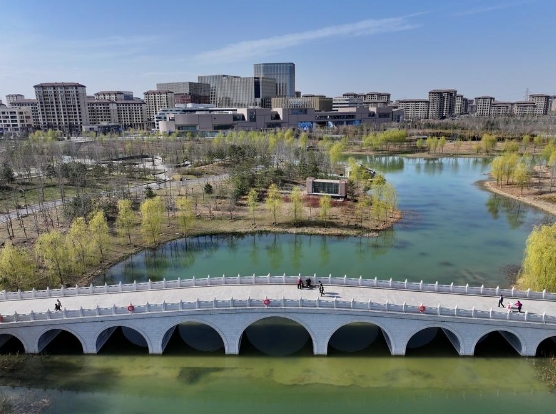Sensing beat of tomorrow in China's "city of future"

As I board a high-speed train bound for Xiong'an New Area, the "city of the future" in northern China, curiosity fills me. What sets this seven-year-old city apart?
About 50 minutes later, my colleagues and I reached Xiong'an, Hebei Province, from Beijing. As the taxi drove us through the city, the skyline began to take shape. But to our surprise, there were no towering skyscrapers in sight.
Unlike Beijing or Shanghai, most buildings here stand modestly, with heights under 45 meters. Only a select few reach a maximum of 150 meters.
In April 2017, China decided to establish the Xiong'an New Area, part of a strategy to promote the coordinated development of the Beijing-Tianjin-Hebei region. Xiong'an was designed to be a smart and livable city that is innovative, green and free from "urban ills."
Navigating the city's streets, I marveled at the seamless flow of traffic. With a knowing smile, my colleague, who is a seasoned Xiong'an resident, assured me that traffic jams were rare.
"You won't find many red lights holding up the flow of traffic here," he chuckled. "Our transportation management system is truly intelligent."
The abundance of public toilets is striking, with over four facilities available per square kilometer -- a stark contrast to Los Angeles' less than 0.2. Beneath the streets, a network of underground pipelines ensures smooth operations, with no disruptive power lines in sight.
But what truly struck me was the city's preferred mode of travel. "You see," my colleague explained, "in Xiong'an, we prefer to walk."
The "15-minute life circle" ensures residents can easily access all their essential needs from shopping to healthcare.
As a multi-centered city, each cluster in Xiong'an is as large as a small town, aiming to prevent urban problems caused by excessive population concentration in single-centered cities.
Similar to other rapidly urbanized regions around the world, Xiong'an is dedicated to maintaining a balance between modernity and tradition.
During my visit to an urban planning exhibition hall, I was inspired by sand table models displaying the entire new area. Traditional elements like porcelain, jade seals, ancient stone bridges and traditional Chinese instruments served as inspiration for city landmarks.
Through the establishment of over 2,300 "nostalgia points", Xiong'an safeguards its heritage by preserving old trees and valuable rural architecture.
In Nanwenying community, I met a relocated villager named Li Taozhu. He often takes his grandson to the point, showing him the trees he once climbed and sharing stories about the Temple of Guan Yu, an ancient general known for his loyalty and bravery in battles.
"After all, this is where our ancestors once lived, and we should not forget our past, even as we enjoy a better life," Li said.
Curious to learn more about enduring traditions, I inquired further. "What other traditions remain unchanged?"
"Every month, we host rural markets without fail," Li replied. "Even elderly women eagerly board buses to join in the events."
I visited the Xiong'an New Area Zhongguancun Science Park, a hub for innovation and business. There, I met Liu Jingjing, the park's general manager, who juggles a hectic schedule, receiving over a dozen batches of high-tech enterprises every day eager to establish a presence.
She expressed confidence in the city's development. "The government has been doing a good job of infrastructure construction. It is now the turn of the market and enterprises to bring vitality to the city."
Amid the city's technological marvels, its essence remains deeply intertwined with nature. While strolling along the shores of Baiyangdian, a prominent wetland in northern China, I spotted various wild birds amidst the serene landscape.
As water quality improves, even the critically endangered Baer's Pochard, a type of diving duck, has been sighted here, a testament to conservation efforts.
According to urban planning guidelines, residents will have convenient access to parks within 300 meters of their homes, with tree belts within 1 km, and forests within 3 km.
Reflecting on my journey through Xiong'an, I was struck by its harmonious fusion of modernity and tradition. It's a place where innovation thrives, nature flourishes, and history permeates every corner. I'm confident that it will continue to captivate all who are fortunate enough to experience its wonders in the years to come.
Editor:伏娅敏
